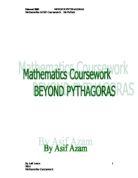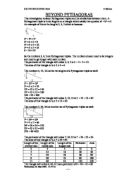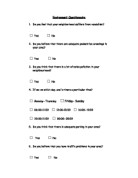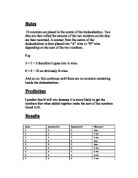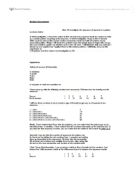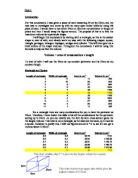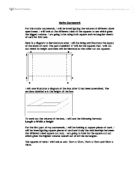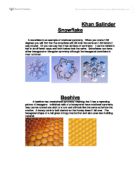Mathematics Coursework - Beyond Pythagoras
) The numbers 3, 4, and 5 satisfy the condition 3² + 4² = 5² because 3² = 3x3 =9 4² = 4x4 = 16 5² = 5x5 = 25 and so 3² + 4² = 9 + 16 = 25 = 5² I will now have to find out if the following sets of numbers satisfy a similar condition of (smallest number) ² + (middle number) ² = (largest number) ². a) 5, 12, 13 5² + 12² = 25 + 144 = 169 = 13² b) 7, 24, 25 7² + 24² = 49 + 576 = 625 = 25² 2) Perimeter b) Nth term Length of shortest side Length of middle side Length of longest side Perimeter Area 3 4 5 2 6 2 5 2 3 30 30 3 7 24 25 56 84 4 9 40 41 90 80 5 1 60 61 32 330 6 3 84 85 82 546 7 5 12 13 240 840 8 7 44 45 306 224 9 9 80 81 380 710 0 21 220 221 462 2310 I looked at the table and noticed that there was only 1 difference between the length of the middle side and the length of the longest side. And also if you can see in the shortest side column, it goes up by 2. I have also noticed that the area is /2 (shortest side) x (middle side). 3) In this section I will be working out and finding out the formulas for: * Shortest side * Middle side * Longest side In finding out the formula for the shortest side I predict that the formula will be something to do with the differences between the lengths (which is 2). But I don't know the formula so I will have to work that out.
Beyond pythagoras - This investigation is about Pythagorean triples and the similarities between them.
BEYOND PYTHAGORAS This investigation is about Pythagorean triples and the similarities between them. A Pythagorean triple is three lengths on a triangle which satisfy the equation a² + b² = c². An example of this is the lengths 3, 4, 5 which is because: 3² + 4² = 5² 3² = 3 x 3 = 9 4² = 4 x 4 = 16 5² = 5 x 5 = 25 9 + 16 = 25 So the numbers 3, 4, 5 are Pythagorean triples. The numbers chosen need to be integers and need to get longer with each number. The perimeter of the triangle with sides 3, 4, 5 is 3 + 4 + 5 = 12. The area of this triangle is 1/2 x 3 x 4 = 6 The numbers 5, 12, 13 can be the lengths of a Pythagorean triple as well: 5² + 12² = 13² 5² = 5 x 5 = 25 2² = 12 x 12 = 144 3² = 13 x 13 = 169 44 + 25 = 169 The perimeter of the triangle with sides 5, 12, 13 is 5 + 12 + 13 = 30 The area of this triangle is 1/2 x 5 x 12 = 30 The numbers 7, 24, 25 are another set of Pythagorean triples as well: 7² + 24² = 25² 7² = 7 x 7 = 49 24² = 24 x 24 = 576 25² = 25 x 25 = 625 576 + 49 =625 The perimeter of the triangle with sides 7, 24, 25 is 7 + 24 + 25 = 56 The area of this triangle is 1/2 x 7 x 24 = 84 Length of the shortest side Length of the middle side Length of the longest side Perimeter Area 3 4 5 2 6 5 2 3 30 30 7 24 25 56 84 9 40 41 90 80 1 60 61 32 330 The triangle with sides 9, 40, 41 has a
Environment Questionnaire
Environment Questionnaire . Do you feel that your neighborhood suffers from vandalism? ? Yes ? No 2. Do you believe that there are adequate pedestrian crossings in your area? ? Yes ? No 3. Do you think that there is a lot of noise pollution in your neighbourhood? ? Yes ? No 4. If so; on which day, and is there a particular time? ? Monday- Thursday ? Friday- Sunday ? 06:00-11:59 ? 12:00-15:59 ? 16:00- 19:59 ? 20:00-11:59 ? 00:00- 05:59 5. Do you think that there is adequate parking in your area? ? Yes ? No 6. Do you believe that you have traffic problems in your area? ? Yes ? No 7. Do you think that there is adequate lighting in your area? ? Yes ? No 8. Do you think that it is safe to go out at night? ? Yes ? No 9. How happy would you be to let your children play outside without parental provision? ? Very Happy ? Happy ? Not so happy ? I wouldn't allow it 0. Do you think that there is adequate security in your area? ? Yes ? No 1. Would you be happy to leave your house empty for long periods of time? ? Yes ? No 2. Do you think that there is a lot of air pollution in your area? ? Yes ?
Maths Dice Investigation
Rules 10 counters are placed in the centre of the dodecahedron. Two dice are then rolled the amount of the two numbers on the dice are then recorded. A counter from the centre of the dodecahedron is then placed into "A" wins or "B" wins depending on the sum of the two numbers. E.g. 3 + 2 = 5 therefore it goes into A wins 6 + 4 = 10 so obviously B wins And so on. this continues until there are no counters remaining inside the dodecahedron. Prediction I predict that B will win because it is more likely to get the numbers that when added together make the sum of the numbers found in B. Results Game Counters in A Counters in B Who won ? 5 5 draw 2 4 6 b won 3 3 7 b won 4 5 5 draw 5 5 5 draw 6 4 6 b won 7 3 7 b won 8 6 4 a won 9 2 8 b won 0 4 6 b The results table clearly see that after rolling 2 dice 10 times the number of counters placed in either "A" wins or "B" wins add up to 10. This is obviously because we used 10 counters. After carefully looking at the results table it becomes apparent that "A Wins" "B Wins" Win = 1 Win = 6 Draw = 3 Draw = 3 Lose = 6 Lose = 1 We can write this as a probability equation: P(A Wins) =
Border coursework
Borders Courseworkcoec ec" . "r se" . ec . "ec" . "w or". ec . " " . ec . "k inec foec " . ec . ". Aim: To investigate the sequence of squares in a pattern as shown below: In this investigation, I have been asked to find out how many squares would be needed to make up a certain pattern according to its sequence. In this investigation I hope to find a formula which could be used to find out the number of squares needed to build the pattern at any sequential position. Firstly I will break the problem down into simple steps to begin with and go into more detail to explain my solutions such as the nth term. I will illustrate fully any methods I should use and explain how I applied them to this certain problem. I will firstly carry out this experiment on a 2D pattern and then extend my investigation to 3D.coca ca" . "r se" . ca . "ca" . "w or". ca . " " . ca . "k inca foca " . ca . "! Apparatus: Variety of sources of information A calculator A pencil A pen Paper Ruler A computer to work out equations on I have come up with the following numbers and sequences. This was done by drawing out the sequence.cofd fd" . "r se" . fd . "fd" . "w or". fd . " " . fd . "k infd fofd " . fd . "; Seq no 2 3 4 5 6 7 No of squares 5 3 25 41 61 85 I will use these numbers to try to create a type of formula to get any no of squares in any sequence.coba ba" . "r se" . ba .
Tubes. I was given a piece of card measuring 24 cm by 32cm, and my task was to investigate and come up with as many open ended tubes by using this piece of card
Introduction: For this coursework, I was given a piece of card measuring 24 cm by 32cm, and my task was to investigate and come up with as many open ended tubes by using this piece of card. I would have to use either 24cm or 32cm as my perimeter or length of prism and then I would swap the figures around. The purpose of this is to find the maximum volume for a particular shape. I will begin this coursework by starting with a rectangle, as this is the easiest shape to start of with, and slowly work my way with the following shapes: square, triangle, pentagon, hexagon, heptagon, octagon and cylinder. This will then give me a brief outline of the shape volumes. Throughout the coursework I will be using this formula to help me find the volume: Volume = area of cross-section x length To start of with I will use the 24cm as my constant perimeter and the 32cm as my constant length. Rectangle and Square Length of rectangle Width of rectangle Area in cm2 Volume in cm3 1 1 352 2 0 20 640 3 9 27 864 4 8 32 024 5 7 35 120 6 6 36 152 7 5 35 120 8 4 32 024 9 3 27 864 0 2 20 640 1 1 352 For a rectangle there are many combinations for you to have the perimeter as 24cm. Therefore, I have drawn this table to list all the combinations for the perimeter adding up to 24cm. As you can clearly see, the 6cm by 6cm cross-section gives me the
Tangled Triangles
Tangled Triangles The first thing to do in solving this problem was to draw all the possible triangles which can be made using the given measurements of 40, 60 and 80. When I had exhausted all the possible combinations and eradicated ones which where the same I was left with 20 triangles. (see next two pages) I went about finding all the possible triangles by firstly starting off with one angle. The first angle I used was 40o and I worked out all the possible side combinations, which turned out to be 3 different combinations. But there are different looking combinations which are actually the same so I had to be careful when doing this (see below) These two triangles may look as if they are different combinations but if one of them was flipped over it would look exactly the same as the other. Then I went on to work out the combinations for 60 o as the angle and then for 80 o. This left me with the first nine combinations. The next task was to work out all the combinations using two angles. I started by using 40 and 60 which gave three combinations, then 60 and 80 and then finally 80 and 40. Now I had explored all the possible combinations of two angles and was left with nine more combinations, three for each. When I was doing this I had to be very careful not to repeat the same triangle because the same triangle can often look different the other way round. For
Mathematics Gcse Coursework Tubes Investigation
Mathematics GCSE Coursework Syllabus 1385 TUBES Objective: The coursework is separated into three investigations. The first investigation is to investigate the volumes of open-ended tubes, which can be made from a 24cm by 32 cm rectangular piece of card. The second investigation is to investigate the volume of open-ended tubes, which can be made from any rectangular piece of card. The third investigation is that for a given area of a rectangular piece of card; investigate the volumes of opened tubes, which can be made. Investigation No.1 The aim for investigation no.1 is to investigate the volumes of open-ended tubes, which can be made from a 24cm by 32cm rectangular piece of card. There are two methods that the tubes can be made. Take an open-ended cube for example: The first method that cube can be construct as the height 24cm with the length and width 8cm. This means the cube is constructed using the paper landscape and way the cube will look short and wider. The second method that the cube can be constructs having a height of 32cm with the length and the width 6cm. This means the cube is constructed using the paper portrait and way the cube will look higher and thinner. After using the formula: height x width x length to calculate the volume of cube. The volume of the cube constructed using the first method is 1536 cm3 and the volume of the cube constructed
Tubes Maths Investigation
TUBES INVESTIGATION BE HAPPY. By LEE SUMMERS Tubes Investigation The aim of this investigation is to make tubes out of a piece of paper 24cm by 32 cm. The tubes have no top or bottom face and the main aim is to work out which shape of tube gives the best volume. The first shape I will use to make a tube will be a square base. This is because it's an easy shape to start off with. To work out the volume of the tube I must first work out the area of the base, then multiply this by the height of the tube. The first tube will have the 24cm side of the paper as the base and 32cm as the height, whilst the second will have the 32cm side as the base and the 24cm side as the height. Both of these are shown below: V=bxh =32(6x6) =32x36 V=volume of tube =1152cm3 b=area of base h=height of tube V=bxh =24(8x8) =24x64 =1536cm3 From this I can see that although the paper from which the tubes are made is the same there is a difference in the volumes, with the larger base giving the largest volume. Below are two tables showing the volumes of different cuboid tubes. 32cm base Height (cm) Volume (cm3) x15 24 360 2x14 24 672 3x13 24 936 4x12 24 152 5x11 24 320 6x10 24 440 7x9 24 512 8x8 24 536 24cm base Height (cm) Volume (cm3) x11 32 352 2x10 32 646 3x9 32 864 4x8 32 024 5x7 32 120 6x6 32 152 From these results I can
Investigation into the effect of length upon the resistance of a piece of wire.
Investigation into the effect of length upon the resistance of a piece of


